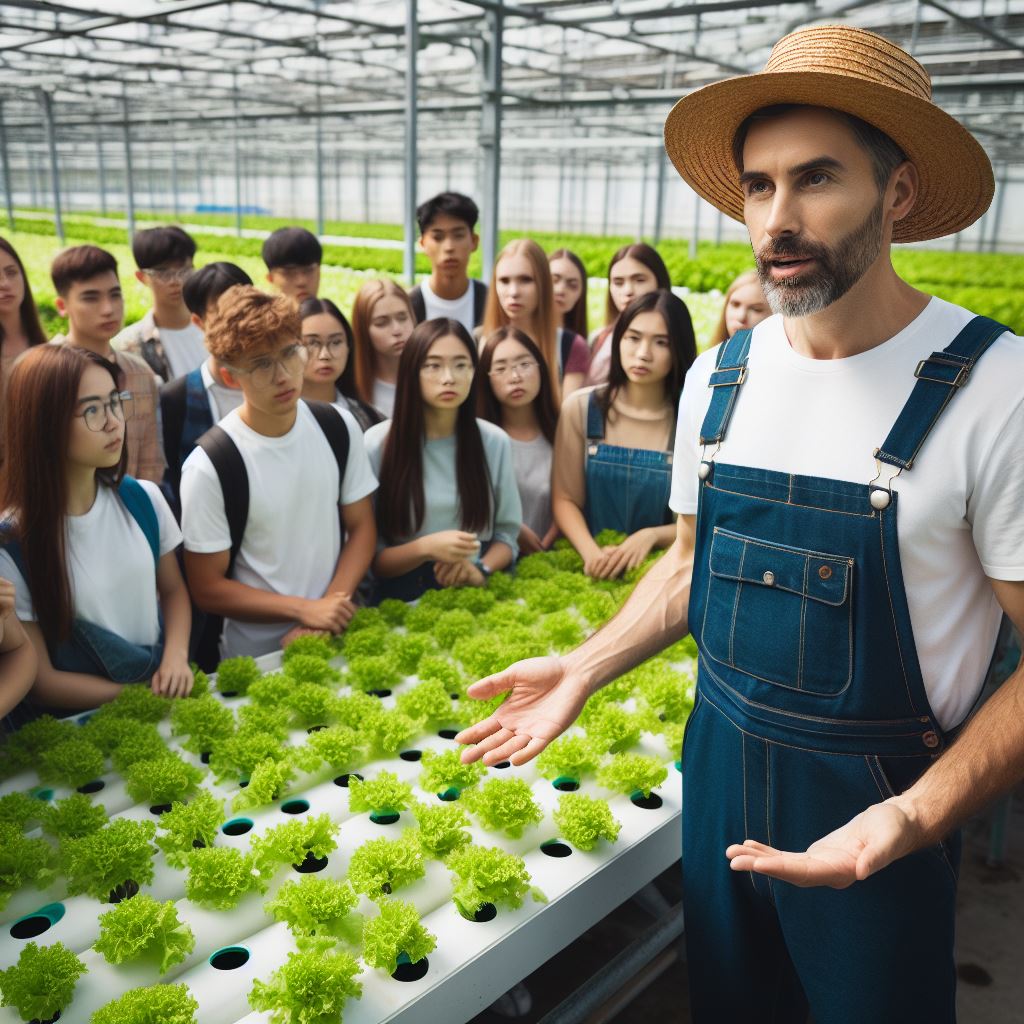Introduction
Hydroponics is a soilless farming technique that involves growing plants in nutrient-rich water solutions.
It eliminates the need for traditional soil and uses alternative mediums like clay pellets or rockwool for plant growth.
Hydroponics plays a crucial role in modern agriculture as it allows year-round crop production, increases yield, and conserves water.
With its controlled environment system, it reduces the use of pesticides and ensures higher food quality.
In this blog post, we will dive deeper into the world of hydroponics, exploring its benefits, techniques, and innovations.
We will discuss the different types of hydroponic systems, such as nutrient film technique, deep water culture, and aeroponics.
Furthermore, we will shed light on the importance of nutrient management, pH levels, and oxygenation in hydroponic farming.
We will also explore the various crops that thrive in hydroponic systems, ranging from leafy greens and herbs to fruits and flowers.
Additionally, we will touch upon the challenges faced in hydroponics, including the initial setup cost, technological complexity, and the need for expertise.
However, we will emphasize how hydroponic farming offers scalable and sustainable solutions for future food production.
Through this blog post, we aim to empower aspiring hydroponic growers, enthusiasts, and anyone interested in modern farming techniques.
Join us on this journey of simplifying high-tech farming through the exciting world of hydroponics.
What is Hydroponics?
Definition and explanation of hydroponics
Hydroponics, also known as soilless gardening, is the practice of growing plants in nutrient-rich water instead of soil.
Unlike traditional farming methods that rely on soil, hydroponics utilizes a variety of growing mediums, such as perlite or coconut coir.
Historical background of hydroponics
Transform Your Agribusiness
Unlock your farm's potential with expert advice tailored to your needs. Get actionable steps that drive real results.
Get StartedThe historical background of hydroponics dates back to the Hanging Gardens of Babylon in the 6th century BC.
Advantages of hydroponics compared to traditional soil-based farming
Advantages of hydroponics include increased plant growth, higher yields, and reduced water usage compared to traditional farming methods.
Hydroponics allows for precise control over nutrient levels, pH, and light exposure, resulting in healthier and faster-growing plants.
This innovative method is gaining popularity due to its ability to grow crops in areas with limited resources, such as arid regions or urban spaces.
Hydroponics provides a solution to challenges faced by traditional agriculture, such as soil degradation and nutrient deficiencies.
Furthermore, hydroponics eliminates the need for pesticides or herbicides, making it a more sustainable and environmentally-friendly option.
The absence of soil also reduces the risk of diseases and pests commonly associated with traditional farming.
Hydroponics allows for year-round cultivation, unaffected by seasonal changes, resulting in consistent crop production.
By providing optimal growing conditions, hydroponics accelerates plant growth, enabling multiple harvests in a shorter timeframe.
In addition, hydroponics uses up to 90% less water compared to traditional farming methods.
This conservation of water is especially valuable in water-scarce regions, promoting efficient resource utilization.
Moreover, hydroponics minimizes the need for agricultural land, making it an ideal method for urban farming initiatives.
The controlled environment of hydroponics also reduces the risk of crop failure due to extreme weather conditions.
In hydroponic systems, plants are provided with a continuous supply of nutrients, ensuring optimal growth and development.
This prevents nutrient imbalances that can occur in soil-based farming, leading to healthier and more nutritious crops.
The absence of weeds also eliminates competition for resources, allowing plants to maximize their growth potential.
Hydroponics enables farmers to grow a wide range of plants, including herbs, leafy greens, fruits, and even flowers.
The flexibility and scalability of hydroponics make it suitable for large commercial operations as well as small home gardens.
While the initial setup cost of hydroponics may be higher compared to traditional farming, the long-term benefits outweigh the investment.
With advancements in technology, hydroponics systems are becoming more affordable and accessible to a wider audience.
In fact, hydroponics revolutionizes farming by providing a sustainable and efficient alternative to traditional soil-based methods.
Its ability to maximize crop production, conserve resources, and eliminate pests and diseases makes it an attractive option for the future of agriculture.
Read: Smart Soil Sensors: Boosting Crop Yields
How does Hydroponics Work?
Overview of the basic principles of hydroponics
Hydroponics is a soilless gardening technique that uses water and nutrient solutions to grow plants.
Showcase Your Farming Business
Publish your professional farming services profile on our blog for a one-time fee of $200 and reach a dedicated audience of farmers and agribusiness owners.
Publish Your ProfileDifferent types of hydroponic systems
Some common types of hydroponic systems include nutrient film technique (NFT), deep water culture (DWC), and ebb and flow.
Explanation of key components in a hydroponics system
A hydroponics system consists of essential components such as a nutrient solution, growing medium, and a water reservoir.
Nutrient solution
A nutrient solution is a mixture of essential plant nutrients that are dissolved in water and provided to the plants.
Growing medium
The growing medium supports plant roots and retains moisture while allowing for the proper exchange of oxygen.
Water reservoir
The water reservoir holds and supplies the nutrient solution to the plants, ensuring continuous hydration.
Benefits of using hydroponics in terms of resource efficiency
Hydroponics offers several resource-efficient advantages compared to traditional soil-based farming methods.
- Water efficiency: Hydroponics uses significantly less water compared to traditional farming as it recirculates and reuses water.
- Space efficiency: Hydroponic systems can be set up vertically or in limited spaces, maximizing land utilization.
- Nutrient efficiency: With precise control over nutrient delivery, hydroponics reduces nutrient waste and ensures optimal plant nutrition.
- Pesticide and herbicide reduction: Hydroponics eliminates the need for soil, reducing the reliance on chemical pesticides and herbicides.
- Higher yields: By providing ideal conditions and nutrient balance, hydroponics often results in higher yields compared to traditional farming.
In short, hydroponics is a high-tech farming method that simplifies plant cultivation by eliminating the need for soil.
Understanding the basic principles, types of systems, and components involved is crucial for successful hydroponic gardening.
The resource-efficient benefits of hydroponics make it an attractive and sustainable option for modern farming practices.
Read: Robotic Farm Hands: The New Agri Trend
Benefits of Hydroponics
Hydroponics offers numerous environmental advantages, such as water conservation and reduced use of pesticides.
One of the major benefits of hydroponics is the increased crop yield and improved quality of produce.
Hydroponics is well-suited for urban farming and can be implemented even in limited spaces.
With hydroponics, cultivation is no longer limited to specific seasons, enabling year-round crop production.
Environmental advantages of hydroponics
Hydroponics presents several environmental benefits that make it a sustainable farming method. One of the key advantages is water conservation.
Unlike traditional soil-based farming, hydroponics utilizes a recirculating water system, where water is constantly reused.
This significantly reduces water consumption and minimizes the strain on local water supplies.
In addition to water conservation, hydroponics also reduces the use of pesticides. In soil-based farming, pesticides are often essential to control pests, diseases, and weeds.
However, in a hydroponic system, pests and diseases are less likely to occur due to the controlled environment.
This results in a reduced need for chemical pesticides, making hydroponics a safer and more eco-friendly farming method.
Increased crop yield and quality with hydroponics
Hydroponics offers a substantial increase in crop yield compared to traditional farming methods.
The controlled environment and optimized nutrient delivery in hydroponics ensure that plants receive the ideal conditions for growth, allowing them to reach their full potential.
As a result, hydroponically grown crops often have higher yields and faster growth rates.
Furthermore, hydroponics promotes better crop quality. The absence of soil eliminates the risk of soil-borne diseases and nutrient deficiencies.
Plants grown hydroponically have direct access to water and nutrients, ensuring they receive a well-balanced diet. This leads to healthier, more nutritious produce that is often preferred by consumers.
Suitable for urban farming and limited spaces
Hydroponics is particularly well-suited for urban farming and locations with limited space. In densely populated urban areas, finding suitable land for traditional agriculture can be a challenge.
However, hydroponics allows farming to take place in controlled environments such as greenhouses, rooftops, or even vertical farms.
By utilizing vertical space and maximizing productivity per square meter, hydroponic systems enable urban farmers to grow crops efficiently in limited areas.
Year-round cultivation possibilities with hydroponics
One of the most exciting aspects of hydroponics is the ability to cultivate crops year-round. Unlike traditional farming methods that heavily rely on seasons and weather conditions, hydroponics provides full control over the growing environment.
By adjusting factors such as temperature, humidity, light, and nutrient delivery, farmers can create optimal conditions for plant growth regardless of the external climate.
This ensures a consistent supply of fresh, locally grown produce even during off-seasons.
In essence, hydroponics offers a multitude of benefits. Its environmental advantages, including water conservation and reduced pesticide use, make it an eco-friendly and sustainable farming method.
Additionally, hydroponics excels in increasing crop yield and quality, making it a highly efficient choice for farmers. Its compatibility with urban farming and limited spaces allows agriculture to thrive in urban settings.
Finally, the year-round cultivation possibilities of hydroponics ensure a consistent supply of fresh produce regardless of the season.
Together, these advantages highlight the transformative potential of hydroponics in simplifying high-tech farming.
Read: Drone Tech in Agriculture: A Game Changer

Challenges and Solutions in Hydroponics Farming
Hydroponics farming offers a modern solution to conventional agriculture, but it also comes with its own set of challenges.
Let’s explore these challenges and the strategies to overcome them for successful hydroponics farming.
Initial setup cost and technical challenges
One of the main hurdles in hydroponics farming is the initial setup cost. The required equipment, such as grow lights, nutrient systems, and environmental control systems, can be expensive.
Additionally, setting up the infrastructure, like water pumps and irrigation systems, may require technical expertise and specialized knowledge.
Showcase Your Farming Business
Publish your professional farming services profile on our blog for a one-time fee of $200 and reach a dedicated audience of farmers and agribusiness owners.
Publish Your ProfileWhen tackling these challenges, it is essential for aspiring hydroponics farmers to conduct thorough research and create a detailed budget plan.
Careful consideration should be given to selecting cost-effective equipment and exploring any available government or financial assistance programs.
Collaborating with experienced hydroponics farmers or seeking guidance from agricultural agencies can also provide valuable insights and help overcome technical challenges.
Maintenance and monitoring requirements
Hydroponics farming demands diligent maintenance and monitoring. Maintaining a balance of essential nutrients, pH levels, and oxygen levels in the water solution is crucial for the plants’ health and growth.
Additionally, regular monitoring of the water temperature, humidity, and light intensity is necessary to ensure optimal conditions for plant growth.
To address these requirements, hydroponics farmers need to develop a strict maintenance routine.
This may involve checking and adjusting nutrient levels regularly, monitoring and controlling environmental factors using automation systems, and conducting routine inspections to identify any signs of plant stress or issues.
Utilizing technology, such as sensors and smart controllers, can simplify and streamline these maintenance and monitoring tasks, making them more efficient and accurate.
Strategies to overcome common issues in hydroponics
Common issues in hydroponics farming include pest control and nutrient imbalances.
Since hydroponic systems provide a controlled environment that can favor the growth of pests and diseases, it is crucial to implement effective pest management strategies.
This may involve using biological controls, such as beneficial insects, or employing preventive measures like regular disinfection and proper crop rotation.
To tackle nutrient imbalances, hydroponics farmers should regularly test and adjust the nutrient solution to ensure a proper balance of macronutrients (nitrogen, phosphorus, and potassium) and micronutrients.
Using advanced nutrient monitoring tools and consulting with agronomists familiar with hydroponics can aid in maintaining the ideal nutrient balance for healthy plant growth.
Examples of successful hydroponics farming
Despite the challenges, numerous hydroponics farmers have achieved remarkable success.
One such example is Gotham Greens, an urban farming company that utilizes hydroponics to grow fresh produce on rooftops in cities.
Their efficient use of space, water, and energy has enabled them to provide local communities with fresh, nutrient-rich greens year-round.
Another successful hydroponics venture is Plenty, a vertical farming company that grows a wide variety of crops hydroponically.
Their use of advanced technology, including artificial intelligence and robotics, allows efficient cultivation of high-quality produce with minimal resources and environmental impacts.
In general, hydroponics farming presents innovative solutions for modern agriculture, but it is not without its challenges.
By addressing initial setup costs, maintaining strict monitoring protocols, implementing effective pest control strategies, and drawing inspiration from successful ventures, hydroponics farmers can overcome these challenges and prosper in this sustainable farming method.
Read: The Rise of Smart Farming Technologies
Future of Hydroponics
In the realm of hydroponics, ongoing research and technological advancements have paved the way for exciting possibilities.
Research and technological advancements in hydroponics
Research in hydroponics is constantly pushing the boundaries, aiming to improve efficiency and crop yields.
Scientists are exploring innovative ways to optimize nutrient delivery systems and improve plant growth.
Advancements in automation, such as smart sensors and control systems, streamline hydroponic operations for maximum productivity.
Potential role of hydroponics in sustainable agriculture
The potential role of hydroponics in sustainable agriculture is immense and cannot be overlooked.
Hydroponics enables cultivation in water-efficient systems, minimizing water usage and reducing the strain on natural resources.
By eliminating the need for soil, hydroponics reduces land requirements, making it suitable for urban areas with limited space.
Additionally, hydroponics can be tailored to operate indoors, providing opportunities for year-round cultivation regardless of climate.
Influence of hydroponics on the future of food production
The influence of hydroponics on the future of food production is undeniable, with several promising implications.
Hydroponics allows for precise control over plant nutrition, minimizing the use of fertilizers and pesticides.
This approach reduces the environmental impact of agriculture, promoting sustainable and eco-friendly food production.
In densely populated urban environments, hydroponics can contribute to local food production, reducing reliance on long-distance transportation.
By shortening the supply chain, hydroponics minimizes food waste and ensures fresher produce for consumers.
The scalability of hydroponic systems also opens doors for commercial farming on a larger scale.
With the ability to stack plants vertically, hydroponics maximizes space utilization and increases crop yields per square foot.
Moreover, the controlled environment of hydroponics provides protection against pests and diseases, reducing the need for chemical interventions.
As technology continues to advance, hydroponics has the potential to integrate with other cutting-edge practices.
For instance, the use of artificial intelligence and machine learning could enhance optimization and decision-making in hydroponic systems.
Aquaponics, a symbiotic system combining hydroponics and aquaculture, further expands the possibilities for sustainable food production.
Showcase Your Farming Business
Publish your professional farming services profile on our blog for a one-time fee of $200 and reach a dedicated audience of farmers and agribusiness owners.
Publish Your ProfileBy leveraging hydroponics alongside renewable energy sources, such as solar power, the carbon footprint of agriculture can be significantly reduced.
As hydroponics gains traction, more research, investment, and collaboration are needed to shape its future trajectory.
In a nutshell, hydroponics is poised to play a crucial role in the future of agriculture.
Research, technology, and sustainable practices will continue to propel this high-tech farming method forward, offering solutions to the challenges of food production in a rapidly changing world.
Conclusion
Hydroponics is a high-tech farming method that simplifies the cultivation process.
It provides several benefits such as higher crop yields, water conservation, and the ability to grow plants in limited spaces.
Throughout this section, we have discussed the basics of hydroponics, including its definition and various types.
We have learned about the key components needed for a successful hydroponic system, such as a nutrient solution, growing medium, and proper lighting.
Furthermore, we have explored the advantages of hydroponics, including its ability to reduce the use of pesticides and fertilizers, as well as its potential for year-round crop production.
We have also touched upon some common challenges faced in hydroponics, such as pH management, disease prevention, and the initial investment required.
It is essential to further explore hydroponics as a sustainable and efficient farming method, considering the increasing demand for food in the future.
With the world population continuously growing, traditional farming methods may struggle to meet the needs of everyone.
Hydroponics presents a viable solution to overcome this challenge by maximizing crop production and minimizing resource consumption.
Hydroponics offers an innovative approach to farming that could revolutionize the future of agriculture.
It is worth exploring and investing in this technology to ensure a more sustainable and food-secure future for all.
Let us embrace the possibilities that hydroponics presents and strive towards a more environmentally friendly and efficient food production system.




